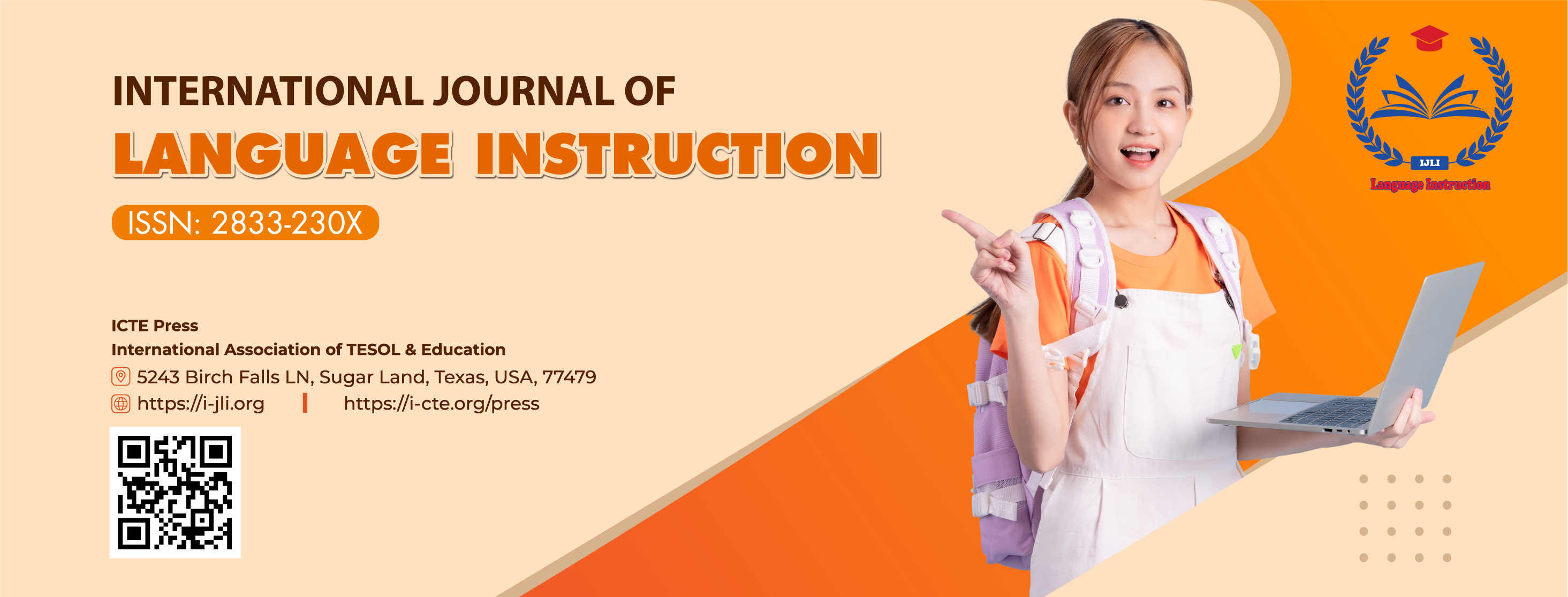EFL Sophomores’ Perspectives on the Application of Computer-Assisted Games in Grammar Classes
DOI:
https://doi.org/10.54855/ijli.25423Keywords:
critical thinking skills , teacher questions, students’ perspectivesAbstract
The integration of computer-assisted games in teaching English has become a current trend in second language teaching. However, research concerning students’ perspectives on the application of computer-assisted games in grammar classes remains limited. Consequently, this study was conducted to explore how 70 EFL sophomores at Van Lang University perceive the use of computer-assisted games in grammar lessons. A mixed-methods approach, combining quantitative analysis from an online survey and qualitative insights from a semi-structured interview, was utilized to collect data. The results revealed that EFL students have a favorable voice towards the implementation of computer-assisted games in grammar classes, emphasizing the benefits of enhancing students’ understanding, learning motivation, and language competence.
References
Ahmad, M., & Wilkins, S. (2024). Purposive sampling in qualitative research: A framework for the entire journey. Quality & Quantity. https://doi.org/10.1007/s11135-024-02022-5
Ahmadi, D., & Reza, M. (2018). The use of technology in English language learning: A literature review. International Journal of Research in English Education, 3(2), 115-125.
Almekhlafi, A. G. (2006). The effect of computer-assisted language learning (CALL) on United Arab Emirates English as a foreign language (EFL) students' achievement and attitude. Journal of Interactive Learning Research, 17(2), 121–142.
Al-Qomoul M., “The Effect of Using an Instructional Software Program of English Language Functions on the Basic Stage Students’ Achievements,” Ph.D. Thesis, Amman Arab University for Graduate Studies, 2005.
Alsied, S. M., Ibrahim, N. W., & Pathan, M. M. (2018). The Use of Grammar Learning Strategies by Libyan EFL Learners at Sebha University. ASIAN TEFL, 3(1), 37-51.
Ayres, R. (2002). Learner attitudes towards the use of CALL. Computer Assisted Language Learning, 15(3), 241–249. https://doi.org/10.1076/call.15.3.241.8189
Belal, A. R. (2011). Students’ Perceptions of Computer Assisted Learning: an empirical study. International Journal of Management in Education, 5(1), 63-78.
Can, G., & Cagiltay, K. (2006). Turkish prospective teachers’ experience with educational software. Educational Technology & Society, 9(1), 76–83.
Chapelle, C. A. (2001). Computer applications in second language acquisition: Foundations for teaching, testing and research. Cambridge University Press.
Chomsky, N. (1981). Lectures on Government and Binding. Dordrecht: Foris.
Creswell, J. W., Clark, V. L. P., Gutmann, M. L., & Hanson, W. E. (2003). Advanced mixed methods research designs. In A. Tashakkori & C. Teddlie (Eds.), Handbook of mixed methods in social & behavioral research (pp. 209-240). Thousand Oaks, CA: Sage.
Debata, P. K. (2013). The Importance of Grammar in English Language Teaching Reassessment. Language in India, 13(5), 482-486.
Douglas, H. (2022). Sampling techniques for qualitative research. In M. R. Islam, N. A. Khan, & R. Baikady (Eds.), Principles of social research methodology (pp. [insert page range if available]). Springer. https://doi.org/10.1007/978-981-19-5441-2_29
Greenbaum, S. (1982). What is grammar and why teach it? In S. Greenbaum (Ed.), The teaching of grammar (pp. 5–19). London: Longman.
Guner, K. (2017). Effects of a Programmed Turkish Grammar Instruction on Students’ Language Skills. Eurasia Journal of Mathematics, Science and Technology Education 13(11), 7539-7547. DOI:10.12973/ejmste/78609
Haudeck (as cited in Sani, H. K., 2016). Senior high school students’ perceptions towards grammar (Unpublished master's thesis). Universitas Kristen Satya Wacana, Indonesia.
Hubbard, P., & Levy, M. (2016). Theory in computer-assisted language learning research and practice. In F. Farr & L. Murray (Eds.), The Routledge handbook of language learning and technology (pp. 24–38). Routledge. https://doi.org/10.4324/9781315657899
Huizhong, Y. (1985). The use of computers in English teaching and research in China. In R. Quirk & H. G. Widdowson (Eds.), English in the world (pp. 86–100). Cambridge University Press.
Januszewski, A., & Molenda, M. (Eds.). (2008). Educational technology: A definition with commentary. New York: Lawrence Erlbaum Associates
Jarvis, H., & Szymczyk, M. (2009). Student views on learning grammar with web- and book-based materials. ELT Journal, 64(1), 32–44. https://doi.org/10.1093/elt/ccp006
Jensen, E., & Sandlin, J. A. (1992). Active learning and the brain: Implications for teaching. In E. Jensen (Ed.), Brain-based learning (pp. 67–80). San Diego, CA: Turning Point Publishing.
Jespersen, O. (2013). Essentials of English grammar. Routledge.
Kayan, A., & Aydin, İ. S. (2023). The effect of computer-assisted educational games on teaching grammar. Journal of Educational Technology & Society, 26(1), 45-58.
Kılıçkaya, F., & Krajka, J. (2012). Can the use of web-based comic strip creation tool facilitate EFL learners' grammar and sentence writing? British Journal of Educational Technology, 43(6), 161–165. https://doi.org/10.1111/j.1467-8535.2012.01298.x
Kohli, A. L. (2007). Techniques of teaching English. Dhanpat Rai Publishing Company.
Larsen-Freeman, D. (2001). Teaching Grammar. In M. Celce-Murcia (ed.), Teaching English as a Second or Foreign Language (3rd ed., pp. 251-66). Boston, MA: Thomson/ Heinle.
Laurillard, D. (2009). The pedagogical challenges to collaborative technologies. Computer-Supported Collaborative Learning, 4(1), 5–20.
Loewen, S., Li, S., Fei, F., Thompson, A., Nakatsukasa, K., Ahn, S., & Chen, X. (2009). Second Language Learners' Beliefs About Grammar Instruction and Error Correction. The Modern Language Journal, 93(1), 91-104.
Mahdi, H. S. (2018). Effectiveness of mobile devices on vocabulary learning: A meta-analysis. Journal of Educational Computing Research, 56(1), 134–154. https://doi.org/10.1177/0735633117698826
Mohamad, F. (2009). Internet-based Grammar Instruction in the ESL Classroom. International Journal of Pedagogies & Learning, 5(2), 34–48. https://doi.org/10.5172/ijpl.5.2.34
Mohamad, F., & Amin, M. (2009). The effectiveness of customized courseware in teaching grammar. Proceedings of the 2nd International Conference of Teaching and Learning (ICTL 2009). INTI University College, Malaysia.
Naba'h, A. A., Hussain, J., Al-Omari, A., & Shdeifat, S. (2009). The Effect of Computer Assisted Language Learning in Teaching English Grammar on the Achievement of Secondary Students in Jordan. Int. Arab J. Inf. Technol., 6(4), 431-439.
Nguyen, H. N. (2020). Teaching English Sounds to Vietnamese Secondary School Students: From Theories to Applications Using Learner-centered Methods. International Journal of Language Instruction, 2(1), 16–29. https://doi.org/10.54855/ijli.23212
Nisha, P. R. (2024). Comparing grammar translation method (GTM) and communicative language teaching (CLT) in EFL context: A qualitative literature review. FOSTER Journal of English Language Teaching, 5(1), 40–48. https://doi.org/10.24256/foster-jelt.v5i1.159
Nutta, J. (1999). Is computer-based grammar instruction as effective as teacher-directed grammar instruction for teaching L2 structures?. CALICO journal, 16(1), 49-62. https://doi.org/10.1558/cj.v16i1.49-62
O'Hare F (1973). Sentence-Combining: Improving Student Writing Without Formal Grammar Instruction. Urbana, IL: National Council of Teachers of English.
Rao, R. K. (2014). Enhancing student’s grammar by using games: A practical classroom experience. International Journal of Academic Research, 1(3), 13-23.
Razak, A. A., Connolly, T., Baxter, G., Hainey, T., & Wilson, A. (2012, October). The Use of Games-Based Learning at Primary Education Level within The Curriculum for Excellence: A Combined Result of Two Regional Teacher Surveys. In Proc. of the 6th Europe. Conf. on Games Based Learning (pp. 401-409).
Sani, H. K. (2016). Senior High School Students’ Perceptions Towards Grammar (Doctoral dissertation, Program Studi Pendidikan Bahasa Inggris FBS-UKSW).
Shafaei, A. (2012). Computer-assisted learning: a helpful approach in learning English. Frontiers of language and teaching, 3, 108-115.
Smith, M. W., & Hillocks, G. (1991). Grammar and usage. In J. Flood, J. M. Jensen, D. Lapp, & J. R. Squire (Eds.), Handbook of research on teaching the English language arts (pp. 591–603). New York, NY: Macmillan.
Squire, K. (2003). Video games in education. International Journal of Intelligent Simulations and Gaming, 2(1), 49–62.
Thornbury, Scott. (1999). How to Teach Grammar. Essex: Pearson Education Limited.
Tu, T. H. P. (2022). The effects of using education technology tools on learning grammar in secondary schools. International Journal of Language Instruction, 1(1), 41–52. https://doi.org/10.54855/ijli.22115
Ural, M. N. (2009). Eğitsel bilgisayar oyunlarının eğlendirici ve motive edici özelliklerinin akademik başarıya ve motivasyona etkisi [The effect of entertaining and motivational properties of educational games on academic achievement and motivation] (Doctoral dissertation). Anadolu University, Educational Sciences Institute, Eskişehir, Turkey.
Warschauer, M., & Kern, R. (2000). Network-based language teaching: Concepts and practice. Cambridge University Press.
Whitton, N. (2007). Motivation and computer game-based learning. In Proceedings of the Australian Society for Computers in Learning in Tertiary Education (ASCILITE).
Young, B. R. (2011). The grammar voyeur: Using Google to teach English grammar to advanced undergraduates. American Speech, 86(2), 247–258. https://doi.org/10.1215/00031283-1337046
Yunita, W., Emzir, E., & Mayuni, I. (2018). Needs Analysis for English Grammar Learning Model from Students' Perspectives. English Review: Journal of English Education, 6(2), 85–94. https://doi.org/10.25134/erjee.v6i2.1258
Downloads
Published
Issue
Section
License
Copyright (c) 2025 Nguyen Thi Thu Hang, Truong Nhat Truong

This work is licensed under a Creative Commons Attribution 4.0 International License.
The copyright of all articles published in the International Journal of Language Instruction (ijli) remains with the Authors, i.e. Authors retain full ownership of their article. Permitted third-party reuse of the open access articles is defined by the applicable Creative Commons (CC) end-user license which is accepted by the Authors upon submission of their paper. All articles in the ijli are published under the CC BY-NC 4.0 license, meaning that end users can freely share an article (i.e. copy and redistribute the material in any medium or format) and adapt it (i.e. remix, transform and build upon the material) on the condition that proper attribution is given (i.e. appropriate credit, a link to the applicable license and an indication if any changes were made; all in such a way that does not suggest that the licensor endorses the user or the use) and the material is only used for non-commercial purposes.
Authors are able to enter into separate, additional contractual arrangements for the non-exclusive distribution of the journal's published version of the work (e.g., post it to an institutional repository, in a journal or publish it in a book), with an acknowledgment of its initial publication in this journal.











